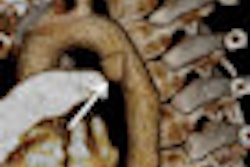A quality control (QC) program can not only lower 3D image generation errors in 3D labs, it can also improve productivity, according to a study published in the January issue of the American Journal of Roentgenology.
The study conducted at Stanford University found that 3D technologist error rates were nearly cut in half following the implementation of a QC program in the university's 3D lab. In addition, the improvement continued well after training ended, even though exam volume increased, according to the research team led by Laura Pierce, now of Duke University (AJR, January 2012, Vol. 198:1, pp. 150-155).
To err is human
"Humans make mistakes -- that is a given -- so every department must implement a method for catching and correcting errors before they have the potential to impact patient care," Pierce told AuntMinnie.com. "Technologists with less experience need continuous mentoring until they become seasoned in 3D postprocessing. A good quality control program will not reduce productivity; our productivity actually improved with the increase in mentoring and the decrease in errors."
Despite its growing importance in diagnosis and results communication, 3D postprocessing is operator-dependent; variations in 3D technologist training and experience can lead to image quality issues and medical errors, according to the authors.
After previous, loosely organized attempts to improve quality in the 3D imaging lab failed to produce the hoped-for result, the institution's 3D lab manager and director teamed up to design and implement a perpetual, structured quality improvement program. Making use of Six Sigma principles, their method included defining the problem, and measuring, analyzing, improving, and controlling quality with structured management involvement, according to the authors.
"This customer-focused approach focuses on prevention of errors through extensive training while including and rewarding participants," they wrote.
3D workflow, imaging protocols, and measurement validation were selected as the primary QC targets. All six full-time technologists in the lab participated in the study, and they ranged in experience from 0.5 to 11 years. Of the group, two senior technologists had more than four years of experience, while four staff technologists had less than four years of experience. All of the technologists postprocess CT and MRI studies full-time using standardized clinical protocols.
Postprocessing consisted of prioritizing and assigning CT or MRI exams to a technologist, generating 3D images at independent workstations, measuring anatomic structures, recording measurements in a clinical report database, and the final transfer of the 3D images to a PACS, according to the researchers.
Documenting errors
During the study, one of the two senior technologists (who did not generate the reviewed image) or the laboratory manager retrospectively reviewed all 3D images on the PACS for errors and error impact. Any errors were documented in a relational database via a Web-based interface and were assigned an error impact category, according to the authors. The image was immediately removed from the PACS and referred to the processing technologist to correct the error.
"This experience was useful for determining error impact and whether a 3D finding required a radiology report addendum," the authors wrote. "Although a single supervisor or manager performed the error review of each examination, the technologists were mostly in agreement with the errors discovered after review of the study was repeated."
If they disagreed with the review, 3D technologists did have the opportunity to discuss issues with the reviewer, who could change the review or maintain it. The 3D technologist could then challenge the error by discussing it with the laboratory manager or director.
Program's effect
The researchers sought to evaluate the impact of the program, first with a three-month observation period from September through November 2008. They then monitored results during a three-month training intervention period from December 2008 to February 2009, as well as a 10-month post-training period from March to December 2009.
3D technologist error rates were as follows for each of the periods:
- Observation period: 16.1% (388 errors/2,413 examinations)
- Training period: 8.2% (190 errors/2,312 examinations)
- Post-training period: 7.2% (563 errors/77,921 examinations)
These results were achieved even with a 7.6% average monthly increase in exam volume.
In other findings, the researchers noted that experience was a key factor in error rates. Technologists with more than four years of experience had a 5.2% mean overall error rate, compared with 10.6% for those with less than four years of experience (p < 0.001). Furthermore, inexperienced technologists realized a much greater effect from training than did experienced technologists (p < 0.001).
The researchers also discovered an increase in the proportion of exams with a turnaround time of four hours or less in the post-training period (p < 0.0001).
Technologist involvement
The authors believe that the initial involvement and collaboration of all lab employees was an important step for receiving feedback and ensuring active participation from the entire group. It can be difficult to maintain a spirit of collaboration when discussing errors, Pierce said.
"For this reason, it is important to involve the technologists in the entire process and continue to get their feedback on ways to reduce errors," Pierce said. "We rewarded the technologist with the best quality score -- aka lowest error rate -- each quarter."
Common causes of errors identified by technologists were as follows:
- Rushing to increase patient throughput
- Loss of focus due to interruptions
- Failure to review images before sending them to the PACS
- Failure to confirm the correct postprocessing protocols
The technologists suggested the following methods to reduce errors, according to the authors:
- Using headphones to eliminate distractions
- Reviewing examinations thoroughly before transporting 3D images to the PACS
- Soliciting advice from senior technologists when uncertain about processing protocols
- Improving consistency and documentation of technologist training
- Requiring that QC examination reviewers periodically cross-check one another's QC results to ensure agreement and consistency
- Improving written communication of protocol revisions
As for other 3D labs who are contemplating a QC program, Pierce suggests they involve technologists in discussions about methods for reducing errors, provide incentives, and ask radiologists to give continuous mentoring.
"Provide an environment that encourages learning and emphasizes that mistakes are going to happen, but they will be caught in time and immediately corrected with a good quality assurance program in place," Pierce advised. "And it's always important to give positive feedback for a job well done!"



















